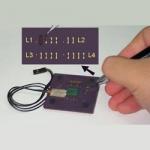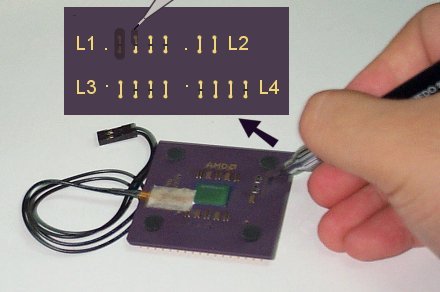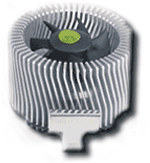Unlocking the Duron and Athlon Using the Pencil
Unlocking the Duron and Athlon Using the Pencil
Introduction

The best and most stable way to overclock your Athlon and Duron CPU is through changing the CPU clock multiplier. Overclocking can be done by changing the FSB (front side bus) of the motherboard, but the Athlon doesn't respond well to overclocking that particular way. To get your Athlon CPU ready to be overclocked requires a slight modification of the CPU called "The Pencil Trick".
The Pencil Trick unlocks the full potential of your CPU. Overclocking the Intel series of CPUs is different than that of an Athlon, and was done mainly by tweaking the FSB of the CPU on the motherboard. FSB overclocking methods, such as running your 300A Celeron set to run at 450MHz by setting the FSB to 100MHz x 4.5 instead of the factory setting of 4.5 x 66MHz, were done very easily. This resulted in a stable overclocked CPU at 450MHz. If you tried overclocking your Athlon in such a way, your system would never POST because the Athlon is not designed like the Intel chip to be compatible at the higher frequencies of an increased FSB. The only drawback to this is that the potential for customers to be ripped of by untrustworthy dealers selling overclocked CPUs to the public at the price of the actual CPU speed is increased by a large margin. Intel long ago locked the multiplier of their CPUs to keep such things from happening with their processors. So with the Intel, chip adjustment of the FSB was the only available option for overclocking.
The Athlon CPU is not designed to handle a high frequency FSB, but will allow you to reconnect the L1 bridges, allowing the processor to be set at any clock frequency, making overclocking an easy task. In the first releases of the Athlon/Duron motherboards you had to not only modify the processor, but you had to modify the motherboard to be able to adjust the Vcore and voltage settings to get a stable overclocked system. But manufacturers soon got the point and started to include those features on their motherboards, making the CPU the only modification you need to make. This works, and is very risk free. The room for error is not great, so even the not-so-mechanically-inclined can take on this task and be successful. I have always been against too much modification, because it can result in the loss of equipment. I wholeheartedly believe in this procedure, as the modification is very minimal and the chance of ruining your equipment is almost zero.
Contents
1. Introduction
2. Setup
3. Step 1
4. Step 2
5. Step 3
6. Conclusion
Setup
You will need a very small-tip pencil, preferably a 0.5mm-type mechanical pencil such as the one made by Ritter, as the tool for this procedure. People think this is absolutely a crazy idea, but it actually works great, and is very easy to do. Lead will not burn at the frequencies running along it, so there is no fear of that happening, as is suggested by some. The L1 Bridges on The Athlon/Duron CPUs are the bridges that lock the multiplier. These bridges are cut off by laser at the factory to lock the CPU at a certain clock frequency, but can be reconnected by using the graphite of the pencil lead to conduct electricity across the bridge, effectively unlocking a locked processor. This is safe and relatively simple to do. Just take your time and follow a few simple procedures

Step 1
Remove your processor from your system and find a well-lit and flat working area. Set your CPU on something that won't damage the pins of the processor. Locate the L1 bridges on the CPU and get your mechanical pencil ready for action. Both the Athlon and Duron processors have the same L1 connecting bridges and are done in the same way.
Step 2
Hold your CPU in your left hand and look very closely at the CPU, so as to clearly see the L1 bridges. Use a business card to separate the bridges so that you do not connect the L1 bridges to each other. Work your way across the bridges from left to right (using a business card as a separation tool) and connect the bridges by rubbing the pencil back and forth over the bridges about twenty times until it is dark black, not the normal gold color. Make sure that all the bridges are reconnected, but not touching each other, and you are on your way. I know it sounds incredible, but that is actually all there is to it. Your processor, if done correctly, is ready to be overclocked. It can now be set to run at different clock frequencies, eliminating the need to increase the FSB.

Step 3
Reinstall your processor back into your system. Make sure you use a good cooling solution, such as the Silver Orb by Thermaltake or an equivalent, as the CPU will need to have better cooling in an overclocked state. Use thermal grease if you have it, preferably a silver-based compound. You can see some good stuff at www.arcticsilver.com. It is messy, but it is very necessary when you are overclocking your CPU, as it makes a seal with the cooling solution for better heat dissipation. You may need to adjust the voltage in order to obtain a stable overclocked CPU. I had to increase the voltage by .05 percent, but then everything ran stable. I was able to run a 650MHz Duron at 800MHz and a 700MHz Athlon at 900MHz just by using a pencil and a few BIOS adjustments. This is a very easy task and can be done by just about anyone who has access to a pencil. I like the mechanical pencil, but a sharp There are many motherboards out currently on the market that support overclocking and have good features to insure you have a properly running, stable system.

Conclusion
This is the simplest and easiest way to modify a CPU that I have ever seen. You can gain a significant amount of increased processor power for the cost of about five cents of pencil lead. Those who are still reluctant, let me tell you I was too, until one day I just gave it a shot, and it was so simple I had to laugh at myself for waiting so long to try it. The Athlon and Duron Processors respond very well to this, and can be set to run at many different speeds with the right combination of settings. All I have to say in closure is take a chance. Grab your Athlon/Duron processor, get a pencil, and unlock that CPU of yours. Then you can get the most performance out of it.

0 comments:
Post a Comment